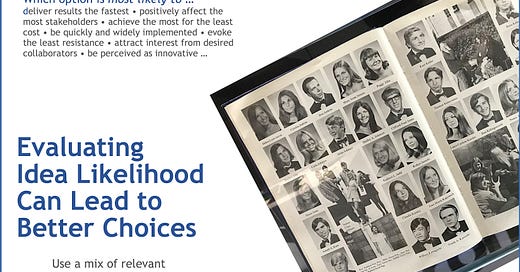Evaluating Idea Likelihood Can Lead to Better Choices (Facilitation Friday #60)
A decision-making technique that may be "Most likely to" evoke strong memories.
When it comes to stocking your facilitator toolbox, wouldn’t it be nice to have an unexpected yet valuable way of helping groups make better choices?
The approach that follows might just earn some votes as “Most likely to do just that.”
Even if it wasn’t standard practice for your school yearbook or awards ceremony, you likely know what people mean if they reference being voted “Most Likely To _____.” It is a trope often mentioned in TV shows and movies, usually to get a laugh.
Guess what? It also is a useful decision-making technique, one we’ll call MLT going forward.
Inroducing the Most Likely To (MLT) Technique
This simple technique reflects the core principle of any good decision-making tool or technique: it engages participants in parallel thinking by having them all use the same criteria to evaluate options under consideration. Though their subjective assessments may vary, using the same evaluation categories or criteria makes for a more objective discussion overall.
When introducing this technique, it can be useful to distinguish between probability and likelihood:
“Probability attaches to possible results; likelihood attaches to hypotheses.”
Presidential Column, C. Randy Gallistel, Association for Psychological Science
Asking participants which idea is “most likely to _____” asks them to hypothesize, not accurately predict an outcome from constrained options such as calling heads or tails for a coin toss.
Using the MLT/Idea Likelihood
Have participants brainstorm MLT categories appropriate for the choice(s) under consideration and then select 5-7 that matter most. If time is limited, you could provide participants with a sample list of appropriate categories and help them revise it as desired.
Participants next assign each option or idea under consideration to one or more of the chosen MLT categories. Tally the votes cast and share the results. Facilitate discussion of the results, treating them as a “sense of the group,” not a final decision. Explore what, if any, data exists for each of the likelihood categories and voting outcomes.
Generally, MLT is one of several tools or techniques I would use to help a group make better decisions as opposed to using it alone.
Casting Votes
Use an approach that efficiently gathers votes from the number of participants involved. I have two defaults, each using the same basic design: put all options or ideas to be evaluated into a numbered list. Participants use the corresponding numbers when casting their votes for which ideas/options are “most likely to ____.”
Online survey. While predictable for virtual gatherings, I often use it when facilitating in-person meetings, particularly when the group is large. After we determine the MLT categories, I have participants take a short break during which I generate the online survey listing the chosen MLT categories. When they return, I give them a link to the survey and ask them to take it using their phones, tablet, or laptop. For each of the MLT categories they “vote” by inputting the number of the corresponding option or idea.
Wall Balloting. Instead of creating a survey during the break, I:
individually list each MLT category on a large manila envelope;
display a numbered list of options/ideas on either a slide or a flipchart; and
distribute a set of the corresponding numbers to each participant. I made my own using these affordable wood chips.
For voting, I typically tape the envelopes to the wall and have participants drop their chosen numbered chip in each one.
If MLT categories and options under consideration are known in advance of a convening a conversation, online surveying could be pre-work for everyone to complete. Distribute tallied results prior to the meeting and use them as a catalyst for conversation when people gather to make final decisions.
Sample MLT Categories
Which idea or option is most likely to …
do the greatest good if almost universally implemented?
be implemented most easily?
attract new or more donor or sponsor financial contributions?
be adopted by the broadest mix of stakeholders?
have the most impact for the least cost?
win the support of key constituencies?
accelerate progress on the strategic plan?
generate the most revenue?
deliver results the fastest?
positively affect the most stakeholders?
achieve the most for the least cost?
be quickly and widely implemented?
evoke the least resistance?
attract interest from desired collaborators?
be perceived as innovative?
If appropriate for the culture of the group I’m facilitating, I sometimes introduce the technique and do a verbal trial run of the voting process using a few categories just for fun, such as:
Most likely to:
evoke groans from Finance or IT?
get people cheering wildly?
leave people stunned into silence?
cause your #1 curmudgeon to smile in support?
Bottom Line
Having a variety of decision-making tools and techniques in your facilitator toolbox makes it easier for you to help groups make more informed and/or better choices. Using “most likely to” ratings is a quick and unexpected way to help surface thinking that otherwise might not be considered.
Getting in Action
Create your own list of 10-15 “most likely to” categories you could use in just about any facilitation effort.
Think of a decision you recently made or are currently contemplating. Do a trial run of the MLT technique and assess a few of the options involved using some of the categories you identified for #1.
Imagine you are facilitating a strategic planning session (or select another specific context). If you could only use 5-7 “most likely to” categories, which ones would you select?
© Facilitate Better and Jeffrey Cufaude. All rights reserved.
To affordably license this content for reprint on your site or in electronic or print communications or to contact me regarding customized facilitation skills workshops or consultations, complete this form.




